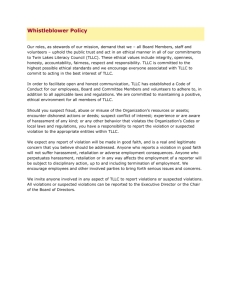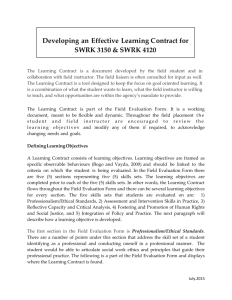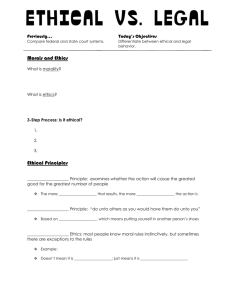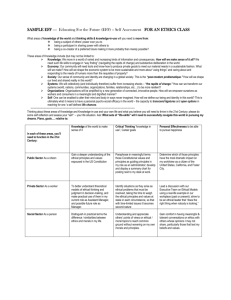Apply for Human Relations requirement status
advertisement
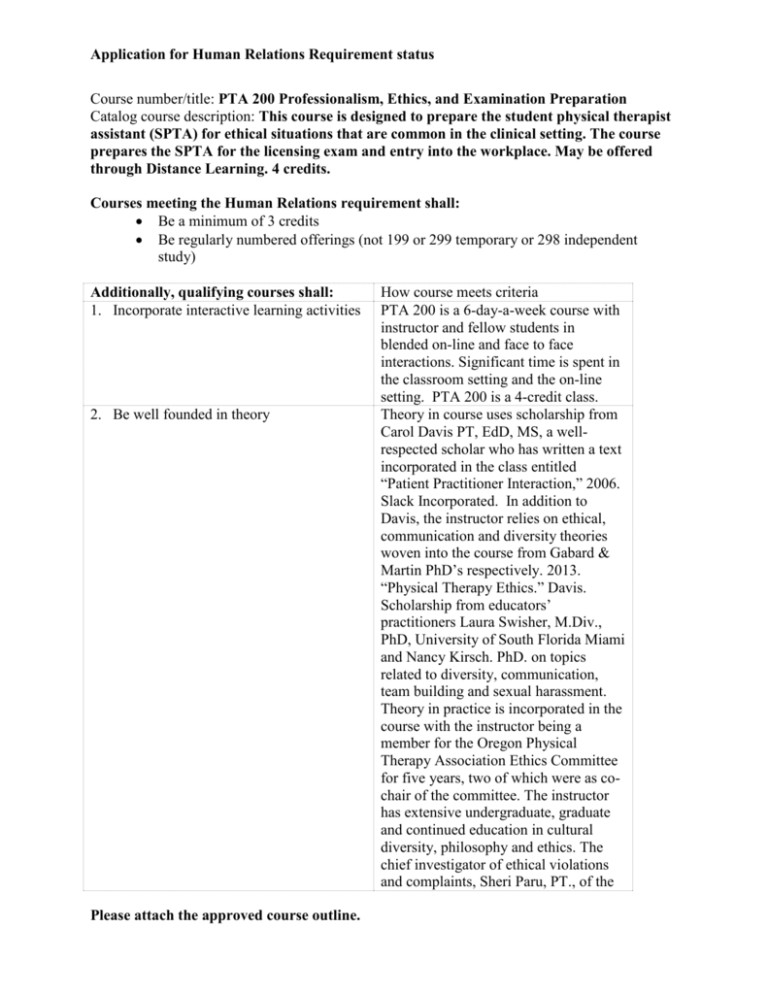
Application for Human Relations Requirement status Course number/title: PTA 200 Professionalism, Ethics, and Examination Preparation Catalog course description: This course is designed to prepare the student physical therapist assistant (SPTA) for ethical situations that are common in the clinical setting. The course prepares the SPTA for the licensing exam and entry into the workplace. May be offered through Distance Learning. 4 credits. Courses meeting the Human Relations requirement shall: Be a minimum of 3 credits Be regularly numbered offerings (not 199 or 299 temporary or 298 independent study) Additionally, qualifying courses shall: 1. Incorporate interactive learning activities 2. Be well founded in theory Please attach the approved course outline. How course meets criteria PTA 200 is a 6-day-a-week course with instructor and fellow students in blended on-line and face to face interactions. Significant time is spent in the classroom setting and the on-line setting. PTA 200 is a 4-credit class. Theory in course uses scholarship from Carol Davis PT, EdD, MS, a wellrespected scholar who has written a text incorporated in the class entitled “Patient Practitioner Interaction,” 2006. Slack Incorporated. In addition to Davis, the instructor relies on ethical, communication and diversity theories woven into the course from Gabard & Martin PhD’s respectively. 2013. “Physical Therapy Ethics.” Davis. Scholarship from educators’ practitioners Laura Swisher, M.Div., PhD, University of South Florida Miami and Nancy Kirsch. PhD. on topics related to diversity, communication, team building and sexual harassment. Theory in practice is incorporated in the course with the instructor being a member for the Oregon Physical Therapy Association Ethics Committee for five years, two of which were as cochair of the committee. The instructor has extensive undergraduate, graduate and continued education in cultural diversity, philosophy and ethics. The chief investigator of ethical violations and complaints, Sheri Paru, PT., of the Application for Human Relations Requirement status 3. Connect course skills to practical application 4. Require significant out-of-class practice of skills Oregon Physical Therapist Licensing Board is a guest lecturer. Her practical exercises, based on theory, are chiefly aimed to educate students on effective communication strategies, and diverse ways of knowing as members of a team and when working with the public The instructor would be a practicing licensed healthcare provider who uses case studies based on real life scenarios, respecting confidentiality and case studies suggested by scholars cited above. Students are asked to reflect on course skills such as enhanced communication, resolving ethical dilemmas, and diversity and to apply course skills to real life practice. After reflection, students complete assignments and exercises based on connecting course content to practical experiences. Students have 6 weeks of 40+ hours a week opportunities to weave theory and practical considerations into their clinical sites during the course. Students are asked to contribute to in class group projects and assignments real experiences from the clinic related to ethics, communication, teambuilding, stress management, diversity, and sexual harassment. Courses that qualify for AAS Human Relations status will require students to demonstrate competency in at least three of the following outcomes. Students successfully completing this course will: Related course learning outcome 1. Describe and utilize appropriate communication 13. Effectively communicate skills including non-verbal communication and mental health status to peers, active listening. supervising PT, and interdisciplinary team. Students listened to pod-casts of material on intercultural communication and actively engaged with instructor and peers on topics ranging from learning what assertive behavior is and Please attach the approved course outline. Application for Human Relations Requirement status 2. Describe the characteristics of an effective work team, the typical stages of team development, and how to be a capable team member. Please attach the approved course outline. how to practice assertive behavior in the professional world. Students interacted with instructor and peers in an on-line format through determined groups and through break-out sessions during three five hour inclass meetings. Students were graded on professional communication daily by instructor based on ability to give and receive feedback respectfully. A criterion of professional communication grading is based on suggestions by published author Carol Davis PhD Patient Practitioner Interaction, Lane Community College Physical Therapist Assistant Program Policy Manual. Specifically, the Program Policy Manual chapters on communication and professionalism. The Physical Therapist Assistant Program (PTA) educators are in constant communication regarding student progress regarding student professional communication in clinic, and through student meetings. The collaborative nature of the faculty in the PTA program assists students in getting consistent feedback on areas of strength in communication and in areas where improvement in communication in the classroom, clinic and during patient interaction is needed. 10. Identify potential causes of conflict of interest in the clinical settings which impact ethical practice and reimbursement patterns. Students learn and integrate Application for Human Relations Requirement status 3. Understand the issues involved in working with people from different cultural backgrounds and how to work effectively in a diverse workplace. through practical exercises in class and in clinical practice the 4 stages of team development forming, storming, norming and performing. Fundamental to their existence as practitioners, student physical therapist assistants (SPTA), work directly in a team with their supervising PT’s. and are graded on their capability in this role. The instructor act as the supervising PT’s and, as part of the PT/PTA team, SPTA’s support the autonomy of the PT according to state law and the professional guide to conduct for PTA’s both of which clearly articulate the competence and cohesiveness needed for PTA’s to be part of a health-care team in light of best practice and as a provider of patient care. 6.Increase awareness of access and rights of individuals with disabilities 7.Understand cultural barriers that impact access and rights of individuals with disabilities 8.Identify factors that contribute to or are barriers to participation in the plan of care as determined by the PT 12. Identify inappropriate sexual behaviors and implement strategies to avoid such behaviors 13.Effectively communicate mental health status to peers, supervising PT, and interdisciplinary team. 14.Demonstrate advocacy for individuals who may benefit from physical therapy through direct contact with legislators. Students learned about the history Please attach the approved course outline. Application for Human Relations Requirement status of marginalization in healthcare faced by people of color, individuals with disabilities, Latinos and members of the GLBTQ communities. Students learned and are later tested on strategies based on best practice on how to work effectively and heightened sensitivity with individuals from different cultures and different religious backgrounds. Students also learn from real civil rights cases local, state and federal laws on protection for specific groups of historically marginalized populations and are later tested on this material. The physical therapy (PT) code of ethics and standards for conduct are learned and applied in which PTA’s act in a respectful manner toward each person regardless of age, gender, race, nationality, religion, ethnicity, social or economic status, sexual orientation, health-condition or disability. Students participate and are graded on discussions about the PT code of ethics and standards for ethical conduct and are tested on this material. The rationale for group discussions and testing on the material is for the students to assess their understanding of the richness and variety of cultural diversity among peers and for the instructor to determine if students are culturally competent and ready to enter work environments rich in diversity. 4. Describe and demonstrate the rules of “principled negotiation” and conflict resolution. Please attach the approved course outline. 1. Identify ethical dilemmas and moral problems 2. Understand foundations in various ethical models that influence moral reasoning 3. Define ethical models Application for Human Relations Requirement status that influence moral reasoning and decision-making and provide an example of each model. 4. Reassess personal code of ethics and describe reasons for keeping or revising personal code of ethics. 5. Identify strategies that can be utilized to support patient’s participation in the physical therapy plan of care Students worked on assignments which challenged them to negotiate with peers, patients and fellow professionals such as nurses and physical therapists based on principled negotiation as a means for conflict resolution, focused on a “win, win” approach to a given situation. For example, students were given a list of patients with various medical problems and were limited on time and could only see a few of the patients. One of the primary objectives was to negotiate with physical therapists and nurses who would get the physical therapy treatments in the limited time period and to explain to the physical therapist and nurse why they made the choices and to negotiate with the other members in this decision making process so that all voices are heard and have some sense of contributing to the outcome/plan of treatments. Students learned the skill of rapport and value of developing rapport with other professionals and patients. Students learned to appreciate how conflicts of interest develop among various providers of care and how to resolve conflicts with the PT/PTA Please attach the approved course outline. Application for Human Relations Requirement status 5. Understand what sexual harassment is, how to prevent it, and how to deal with it if it occurs. relationship, other team members, patients and patient families. 12. Identify inappropriate sexual behaviors and implement strategies to avoid such behaviors Students learned how to identify what constitutes sexual harassment in the workplace and the precedent court cases that define sexual harassment. Case studies about sexual harassment experienced by providers of care by co-workers and patients as well as sexual harassment experienced by patients. Students are then tested on what constitutes sexual harassment and how to respond if they themselves are victims or witness sexual harassment. Students are also tested on the illegality of sexual harassment and on the legal precedent setting Supreme Court decisions on behalf of plaintiffs who were victimized and, are tested on material presented on the fact that as licensed professionals, they are held to a high standard and can potentially get their license suspended or revoked if they are found to be culpable of sexual harassment. The topic of sexual harassment is presented in a lecture format by the instructor and the chief investigator of the Oregon Physical Therapist Licensing Board and students are asked to reflect on a graded assignment on her presentation in a group and individual format. Students are also later tested on her presentation on sexual harassment. The rationale for Please attach the approved course outline. Application for Human Relations Requirement status 6. Identify character traits associated with being an ethical person and use a systematic method for making ethical decisions and behaving ethically. Please attach the approved course outline. having group discussions and graded multiple choice and essay questions is to assess if students understand the nature of sexual harassment, strategies to end harassment, and awareness of the legal ramifications of harassment in the workplace. Students learned about the prevalence of sexual harassment, and how being assertive and reporting harassment early can prevent continued or future harassment by perpetrators. 1. Identify ethical dilemmas and moral problems 2. Understand foundations in various ethical models that influence moral reasoning 3. Define ethical models that influence moral reasoning and decision-making and provide an example of each model. 4. Reassess personal code of ethics and describe reasons for keeping or revising personal code of ethics. Extensive coursework on identifying character traits of an ethical person under categories of self-valuing and self-directing such as authenticity and integrity and character traits of reciprocity and caring for others such as nonmaleficence, justice and altruism. Models for resolving ethical dilemmas based on sound ethical theories were explored and applied to various clinical scenarios. Ethical models applied include the realm, individual process, situation (RIPS), and a model by a professor of ethics, Gabard (PhD) addressing ethical dilemmas in a series of steps that Application for Human Relations Requirement status 7. Describe and give examples of how to effectively manage workplace stress and anger. Please attach the approved course outline. involve fact gathering, options of resolution, action and a review of the process in resolving the dilemma. 8. Identify factors that contribute to or are barriers to participation in the plan of care as determined by the PT 10. Identify potential causes of conflict of interest in the clinical settings which impact ethical practice and reimbursement patterns During the course, students are required to participate in a group forum involving other students, where individual students ask family members, fellow students, instructors, clinical instructors and friends to give honest and specific feedback about their observations of student behavior while the student is under stress. This exercise provided rich feedback for students on how they react under stress in their voice tone and body language. Students were asked to reflect on how their reaction can potentially create a barrier in communication with others. Students actively engaged in exercises based on Mark Silber (1984) Managing Confrontations on how to assertively deal with anger in relations to team-members, supervisors and patients. Students work on modules that address the reality of horizontal hostility among health-care workers and how this workplace stress affects patient care and outcomes. Workplace stress was addressed in exercises on being able to recognize work-place stress and how to effectively deal with Application for Human Relations Requirement status 8. Identify their individual work style (i.e., where they like to focus their attention, the way they like to take in information and the way they like to make decisions), and the strengths and weaknesses of that style. Marc Duyck, MsEd, PTA 9.27.13 Instructor Date Please attach the approved course outline. work-place stress specifically as students and as new professionals. In addition, students were asked to in a group to analyze what the signs and symptoms are of work-place burn-out and how to prevent and cope with burn-out as new professionals. Exercises were based on insights from highly regarded author Ruth Purtilo, PhD (2002) Health Professional/Patient Interaction. Saunders. St. Louis. MO. Students are asked to reflect on learning style preferences and work styles identified a year and a ½ ago with the same instructor, and students are asked openly discuss with the instructor what their work style preferences are. This is especially crucial as they study for a high-stakes licensure exam which is part of the course. The instructor, based on student feedback, modifies exercises, assignments, quizzes and exams based on student input on their individual work-styles. Every week, students are asked to reflect on their work-styles in a submitted journal entry, what they learned in the week best, and what weaknesses in their work style they have identified. This information helps the instructor reach out to struggling students and to offer suggestions on how to improve student and work-style habits to achieve success in the course. _____________________________ Academic Dean Date




